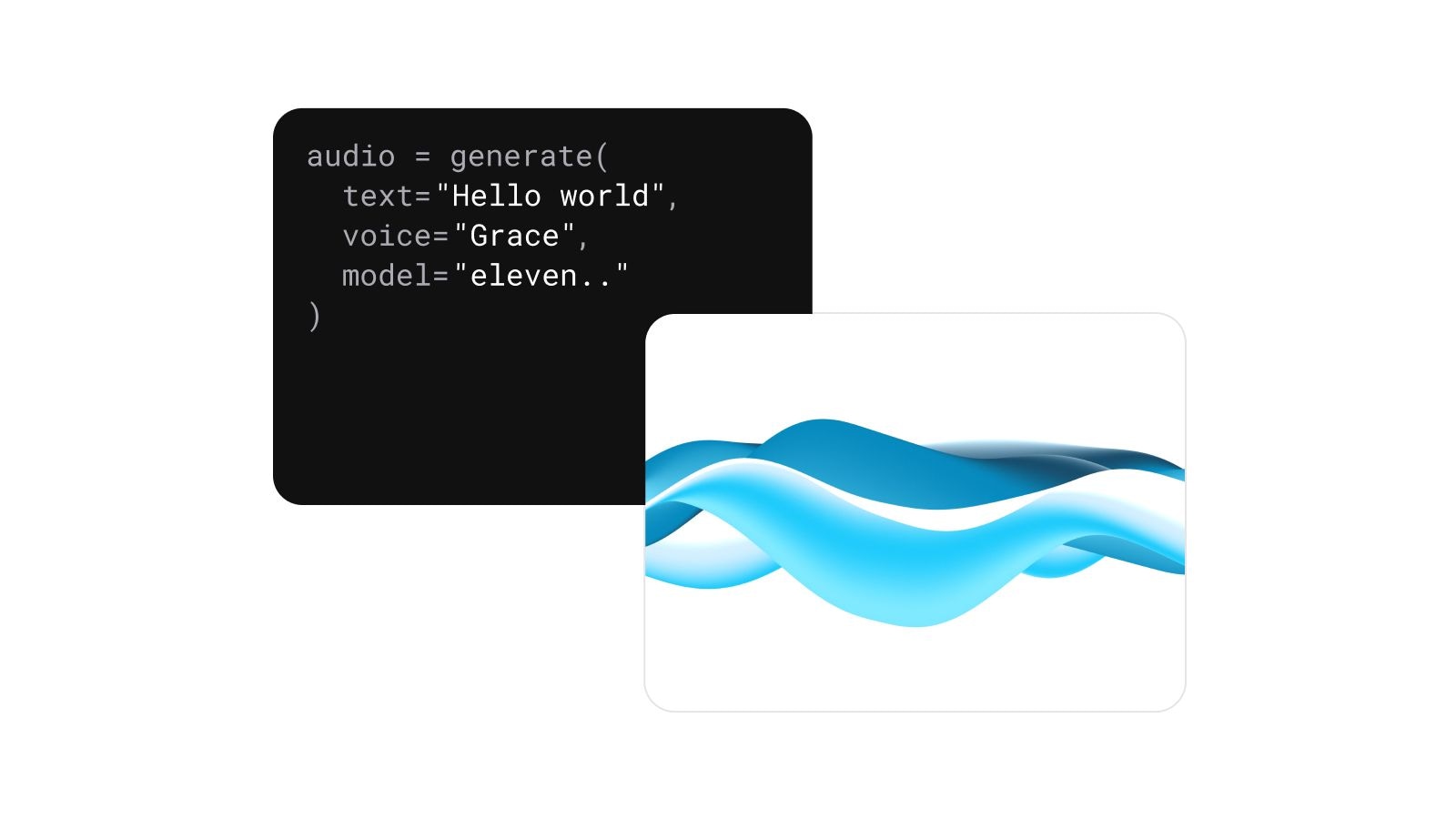
Créez des agents vocaux pour votre entreprise avec notre IA conversationnelle
Une IA qui sonne comme nous et répond en temps réel.
IA conversationnelle devient de plus en plus naturelle, et les avancées en synthèse vocale y contribuent largement. Une sortie vocale optimisée permet aux agents IA conversationnels de répondre de manière humaine en temps réel, changeant notre façon d'interagir avec les machines et leurs applications.
Avez-vous déjà parlé à un assistant virtuel et ressenti un effet de vallée dérangeante ? Comme si quelque chose n'allait vraiment pas ? Eh bien, ce n'est pas surprenant. Une voix robotique et monotone peut rendre même l'IA la plus intelligente impersonnelle et frustrante.
Voici la synthèse vocale optimisée ; le secret pour rendre l'IA naturelle, engageante et, surtout, réaliste. En affinant la conversion du texte en parole, nous créons une IA qui non seulement délivre des informations, mais le fait de manière à donner l'impression de parler à une vraie personne.
Explorons comment la synthèse vocale stimule l'évolution de l'IA conversationnelle et pourquoi l'optimiser est essentiel pour créer des interactions plus intelligentes et engageantes.évolution de l'IA conversationnelle et pourquoi l'optimiser est la clé pour créer des interactions plus intelligentes et plus humaines.

Créez des agents vocaux pour votre entreprise avec notre IA conversationnelle
La synthèse vocale, également appelée Text to Speech, est la technologie qui convertit le texte écrit en mots parlés. Elle permet à l'IA de répondre de manière audible lors d'une conversation.
Au cœur de la synthèse vocale se trouvent les moteurs de Text to Speech (TTS). Ces moteurs utilisent des algorithmes avancés pour analyser le texte, déterminer le ton approprié et générer une parole claire et naturelle. Contrairement à l'audio préenregistré, la synthèse vocale fonctionne de manière dynamique, produisant des réponses en temps réel basées sur les entrées de l'utilisateur.
La synthèse vocale est une bouffée d'air frais pour l'IA conversationnelle. Elle rend les interactions plus accessibles, engageantes et inclusives, assurant que les utilisateurs se sentent connectés et compris.
Alors que les premiers outils de synthèse vocale produisaient un son robotique et monotone, les systèmes TTS avancés peuvent répondre avec des voix proches de celles des humains en un rien de temps.résultat robotique et monotone, les systèmes TTS avancés peuvent répondre avec des voix humaines en un rien de temps.
Ces avancées démontrent l'importance de l'optimisation continue de la synthèse vocale, menant à plusieurs avantages :
Avez-vous déjà remarqué comment les vraies conversations incluent des pauses, des accents et des tons variés ? Une synthèse vocale optimisée imite ces nuances, rendant les réponses de l'IA naturelles plutôt que robotiques.
Le ton et l'intonation sont les pierres angulaires des conversations humaines. La synthèse optimisée permet à l'IA de transmettre des émotions comme l'excitation, l'empathie ou l'urgence, créant une connexion plus profonde avec les utilisateurs.
Le temps est précieux. Un agent IA conversationnel lent peut être frustrant, surtout si vous êtes pressé. Le TTS optimisé garantit que la synthèse vocale suit les entrées de l'utilisateur, offrant des réponses rapides sans compromettre la qualité de l'interaction.
Les avancées en synthèse vocale ont indéniablement conduit à des améliorations significatives dans les résultats de l'IA conversationnelle.
Bien qu'il reste du travail à faire pour atteindre une authenticité complète, la synthèse vocale optimisée a déjà contribué au développement de plusieurs innovations dans de nombreuses industries :
Grâce à la synthèse vocale optimisée, les assistants vocaux comme Siri et Alexa deviennent de plus en plus humains. Ils engagent des conversations naturelles, fournissent des réponses instantanées et ajustent même leur ton en fonction du contexte.
Dans les jeux vidéo, les personnages IA avec des dialogues réalistes donnent vie aux histoires. La synthèse vocale adapte leurs réponses en fonction des actions du joueur, rendant le jeu plus immersif et interactif.
Les tuteurs IA délivrent des leçons avec une voix claire et engageante, répondant aux questions de suivi en temps réel. Que ce soit pour aider avec des problèmes de mathématiques ou enseigner une nouvelle langue, la synthèse vocale optimisée rend l'apprentissage en ligne plus authentique et dynamique.
La synthèse vocale permet aux assistants IA de guider les patients dans des tâches routinières comme la prise de médicaments, le suivi des symptômes ou la prise de rendez-vous. Un ton apaisant et empathique assure que les utilisateurs se sentent pris en charge et soutenus.
La technologie TTS alimente les bots de service client pour répondre aux demandes en fournissant des réponses parlées, améliorant l'expérience globale. Une parole claire et naturelle assure que les utilisateurs se sentent écoutés et compris, même sans agent humain.
En plus des exemples listés ci-dessus, la synthèse vocale optimisée a permis l'introduction d'outils IA conversationnels dans notre quotidien. Bien que nous ne reconnaissions pas toujours sa présence, la technologie avancée de synthèse vocale est derrière de nombreuses interactions réalistes que nous avons avec les assistants IA de nos jours.
Appareils domestiques intelligents : Les assistants virtuels comme Google Assistant utilisent la synthèse vocale pour fournir des mises à jour en temps réel, contrôler les appareils IoT et répondre aux commandes des utilisateurs avec une voix naturelle.
Applications d'apprentissage des langues : Des applications comme Duolingo utilisent le TTS pour modéliser une prononciation précise et guider les utilisateurs dans la pratique conversationnelle, les aidant à gagner en confiance dans de nouvelles langues.
Plateformes de divertissement : Les livres audio et les applications de narration interactive exploitent le TTS optimisé pour raconter des histoires avec des voix engageantes et réalistes qui s'adaptent au ton et au contexte du récit.
Bornes de vente au détail : Dans les magasins, les bornes alimentées par IA utilisent la synthèse vocale pour guider les acheteurs, répondre aux questions sur les produits et faire des recommandations personnalisées, améliorant l'expérience d'achat.
Hubs de transport : Les assistants numériques dans les aéroports et les gares fournissent des annonces en temps réel et une assistance pour l'orientation avec des voix claires et faciles à comprendre.
Plateformes de télémédecine : Les assistants IA dans les applications de télémédecine utilisent la synthèse vocale pour expliquer les instructions médicales, planifier des suivis et fournir des conseils de santé de manière audible, améliorant l'accessibilité et les soins.

Que vous souhaitiez optimiser un agent IA conversationnel existant
Voici comment commencer :
Vous pouvez commencer par sélectionner un narrateur dans la bibliothèque de voix réalistes d'ElevenLabs ou concevoir une voix personnalisée pour s'adapter au contexte de votre marque ou projet.
Ajustez le ton, le rythme et l'intonation pour correspondre au contexte de votre application. Que vous construisiez un assistant de santé, un tuteur virtuel ou un personnage de jeu vidéo, les options de personnalisation sont infinies.
Une fois que vous avez sélectionné et personnalisé la voix souhaitée, intégrez l'API TTS d'ElevenLabs dans votre plateforme IA conversationnelle pour une synthèse vocale dynamique en temps réel.

Notre API de synthèse vocale a une faible latence et s’intègre facilement. Un effort de codage minimal suffit à mettre des voix nettes et de haute qualité dans vos applications.
Exécutez des scénarios pour évaluer comment votre IA sonne dans des interactions réelles. Utilisez les retours pour ajuster les paramètres de la voix et assurer une qualité de réponse optimale.
Déployez votre IA alimentée par TTS et surveillez ses performances. Une surveillance continue aide à maintenir la qualité et à répondre aux attentes des utilisateurs.
Bien que l'optimisation de la synthèse vocale ait conduit à de nombreuses innovations précieuses, des progrès restent à faire. Les défis pressants rencontrés par les développeurs incluent :
Équilibrer vitesse et qualité : Obtenir des réponses rapides et en temps réel sans sacrifier la qualité de sortie est un défi constant. Bien que des outils TTS avancés comme ElevenLabs y répondent avec des capacités de traitement puissantes, il reste encore des améliorations à apporter.
Assurer l'authenticité émotionnelle : Faire en sorte que les voix IA sonnent empathiques ou enthousiastes peut être délicat. Les améliorations continues du TTS aident l'IA à transmettre des émotions plus authentiques, mais reproduire pleinement la sortie vocale humaine est encore en cours.
Développer des capacités multilingues : Adapter la synthèse vocale optimisée à plusieurs langues nécessite de comprendre les nuances culturelles et la prononciation. Des outils avancés comme ElevenLabs offrent un support multilingue pour répondre à ces besoins, mais nous avons encore un long chemin à parcourir avant de pouvoir couvrir toutes les langues.
La synthèse vocale optimisée améliore sans aucun doute les résultats de l'IA conversationnelle, la rendant plus humaine, engageante et accessible. Des appareils domestiques intelligents aux jeux, en passant par l'éducation et la santé, cette technologie change notre façon d'interagir avec l'IA en temps réel.
Bien qu'il reste des progrès à faire en termes de qualité, d'authenticité et de capacités multilingues, des outils TTS avancés comme ElevenLabs offrent aux développeurs un raccourci efficace pour optimiser leurs
Prêt à optimiser la sortie vocale pour votre propre agent ?

Créez des agents vocaux pour votre entreprise avec notre IA conversationnelle

Complete visibility into agent configuration changes and safe, staged rollouts of new versions.

From 3,000 daily calls and long IVR trees to natural, multilingual assistance across phone and web.
Propulsé par ElevenLabs Agents